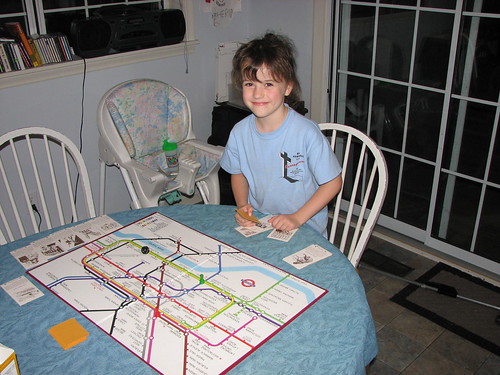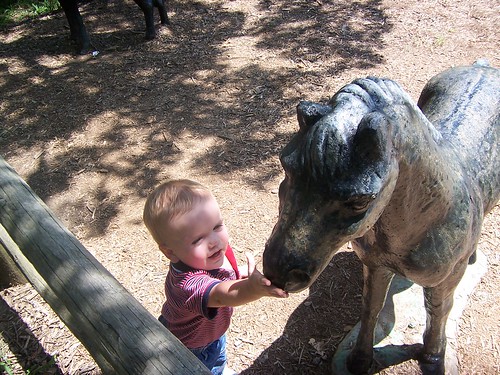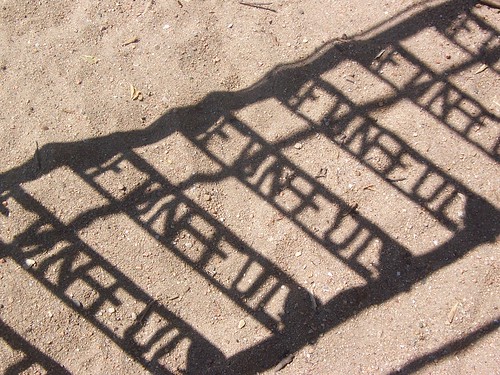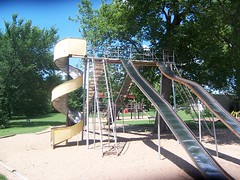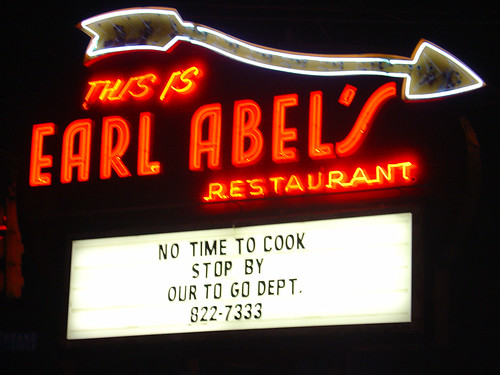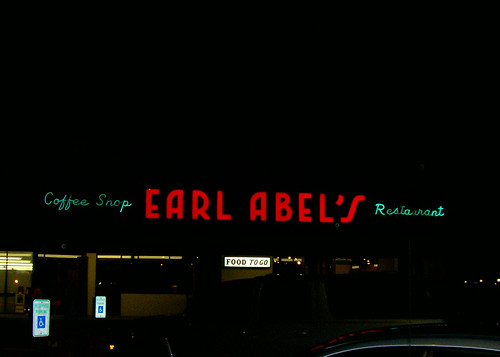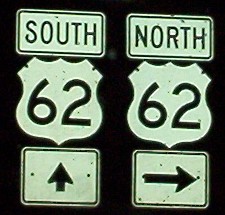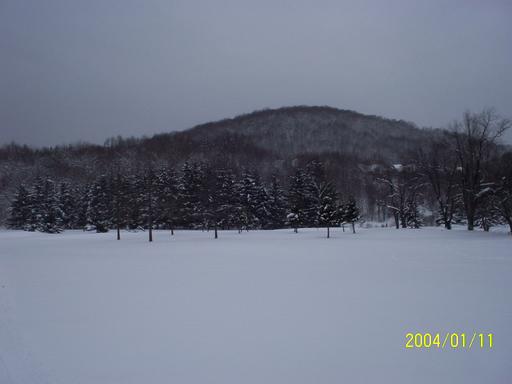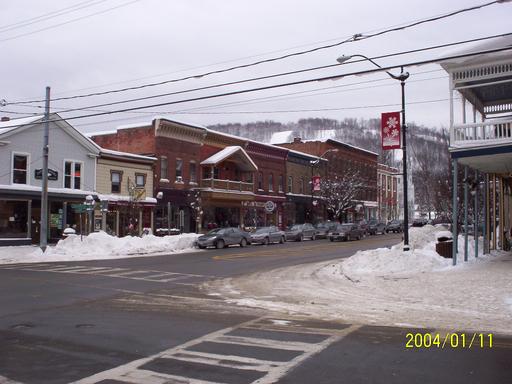My wife's dad's folks are all cotton farmers from west Texas, specifically the area around Stamford, which is just a bit north of Abilene. We drove down and spent fall break there. What follows are some disjointed notes from the trip down and back:
We stopped at the Rock Cafe in Stroud on the way down. It was supposed to be for breakfast, as an incentive for the kids to get up and around early. But then a stray dog, a beautiful and friendly young chocolate labrador, strolled up while I was packing the car. We spent the next couple of hours trying to see if he belonged to anyone in the neighborhood, and called the Humane Society and area vets trying to figure out the best way to get him back to his owner. We finally took him to the animal shelter, figuring the owner would be most likely to look there first. The dog had no collar, no tag, no ID chip. He was not neutered. He was healthy, and although he was thirsty he wasn't hungry, so we figure he can't have come far. We posted a few signs around the neighborhood, and I posted to a couple of Internet pet lost-and-found sites.
But back to the Rock Cafe: We had lunch there. We sat at the counter, and Dawn, the owner, and the inspiration for Sally in the movie Cars, told the kids about the real-life incidents involving the cafe that inspired some of the scenes in the movie. (The DVD is out November 6, by the way!) Everyone enjoyed their lunch. I had the prettiest patty melt I've ever seen -- on marble rye -- with a side of tabouli. Delicious!
Further down the road, we stopped at a Dairy Queen south of Wichita Falls, Texas. You know you're in a small west Texas town when there's a sign on the Dairy Queen that says they'll be open late after home games. Or when the Dairy Queen has the only banquet/meeting room in town.
I liked the way this DQ does kids' meals. They're served in a sack with a coupon for a free DQ treat (Dilly Bar, ice cream sandwich, or ice cream cone). When the kids are done with their real food, they can go back to the counter to pick out their dessert. It's an incentive to finish supper, there's no cheap little toy to deal with, and dessert doesn't melt while they're eating their meal.
Also, the chicken fingers come with cream gravy for dipping.
I had a pepper-pepper burger: It had jalapeno bacon, pepper jack cheese, and chipotle sauce on it. The menu said it was a local favorite.
Favorite high school mascot name spotted on this trip: The Munday Moguls. (Will Bill Gates, Steve Jobs, Warren Buffett, etc., sue the school to change the nickname to something less derogatory?)
Normally when I travel I have no worries about finding a high-speed Internet connection. If the hotel doesn't have it, there'll be a Panera or a local coffeehouse with a free wi-fi connection, or at least a McDonald's (AT&T DSL subscribers can have unlimited use of Wayport hotspots for a tiny monthly fee). I was working on a project and was going to need to upload some large files while we were in Texas, but none of the usual alternatives were available, and we were staying with family who didn't have a computer, much less broadband. My best option looked like driving an hour each way to Abilene. As we were passing through some small towns on our way south, I noticed several motels advertising free high-speed Internet. I made some phone calls and sure enough, the two motels in Stamford both had free wi-fi for guests, although it wasn't advertised on their signboards. Problem solved. $40 (the price of a room with tax at the Deluxe Inn) is a bit steep for a day of wi-fi but it was the cheapest alternative.
I heard several mentions of wind farms in the works for the area, which sits about 1500' above sea level. Folks I talked to didn't think wind turbines in a river valley at 600' elevation was likely to work very well.
You think water is expensive? One relative, who gets city water out in the country, told us they pay $50 a month for the first thousand gallons of water. In Tulsa, that pays for 5,000 gallons, plus sewer, plus trash pickup, plus stormwater fees. Another relative has installed rainwater tanks with a 20,000 gallon capacity, and they collect "gray water" (drainage from sinks and showers) for use in the yard.
US 277 was once paralleled by the Texas Central Railroad, but sometime during the mid '90s the rails were pulled up and the viaducts demolished. You can still see the track bed, usually elevated several feet above the surrounding terrain, and the supports for bridges. Occasionally you'll see piles of railroad ties or lonely old telephone poles (the kind that look like Orthodox crosses). The old track bed and right of way is being reused to turn 277 into a four lane divided highway, and most of the towns between Wichita Falls and Abilene are to be bypassed.
Oddly, US 277 used to bypass Wichita Falls, but now it runs along the western edge of downtown and then west along Kell Boulevard. In the downtown section, they've cantilevered new expressway lanes above existing streets, minimizing the amount of demolition they had to do. The new lanes aren't open yet, and I would still expect to see a certain amount of decay from being in the shadow of the freeway, but I give them credit for trying to provide the highway without dividing their downtown from the surrounding neighborhoods.
My wife's relatives remember going to a hangar dance at the local airport back in the '40s, featuring Bob Wills and His Texas Playboys. More often, though, they'd have house dances -- they'd move the furniture to the walls and roll up the linoleum. A couple of folks would sit in the corner and play fiddle and guitar, and people would dance as best they could in the limited space available. Or they'd go to all-night parties at the Sons of Hermann Lodge in Old Glory -- play games, eat, dance until the wee hours, then roll out their bedrolls and sleep in the hall. (My wife's aunt and uncle preferred to sleep in the camper on their pickup, so the pranksters at these events couldn't get to them.)
Speaking of the Old Glory lodge, next Saturday is the big event of the season -- a sausage supper and dance. Wish we could have been around for that.
Old Glory was originally called Brandenburg, but they changed the name during World War I.
It wasn't until 1961 that my wife's relatives went to mechanized cotton harvesting. Until then, working cotton meant going out and picking it by hand.
Most family get-togethers feature cards or dominoes. Saturday night we played a game of Chicken Foot, a domino game that moves pretty quickly, as about half of your moves are tightly constrained. Each hand begins with a double (in sequence starting with double-nines) and the first eight plays must be off of that initial double, creating eight radial lines from the middle. Subsequent doubles are laid perpendicular to the line of play, and the next three plays have to be off of that double. Double blank counts 50 points if you still have it at the end of the hand.
On the way home, we stopped for lunch at a Texas Roadhouse in Wichita Falls. (I would have stopped at a truly local place, but I hadn't done any research ahead of time.) I gave the baby little bites of my sweet potato. He loved the taste, but with every bite he made the funniest face because of the difference in texture from the usual pureed stuff.
We made our usual stop at Elmer Thomas Park in Lawton, home to a huge prairie dog colony. We watched them pop out of their holes. A lady walking her baby in a stroller gave us some crackers to toss at them, and then a couple who brought some old bread out for the prairie dogs shared some with the kids. The couple told us about seeing all the pups in the park back in June. You can get to the park by heading west from I-44 on old US 62, then south on 6th Street.
I also drove us through Medicine Park, an old resort town, founded about 100 years ago, just east of the Wichita Mountains wildlife refuge. It's distinguished by buildings made of cobblestone, which sit along Medicine Creek. My last visit was four or five years ago, and since that time several more businesses have opened and old buildings are being renovated. Improvements have been made to trails and bridges along the creek. We noticed signs of renovation in the Old Plantation Restaurant (once the Outside Inn, then the Grand Hotel). A number of homes advertised bed and breakfast or cabins for rent. On the north edge of town, we noticed some big and expensive looking new "cabins" up in the hills with a commanding view of the Wichita Mountains. The town still might qualify as undiscovered, but just barely, and not for long.
